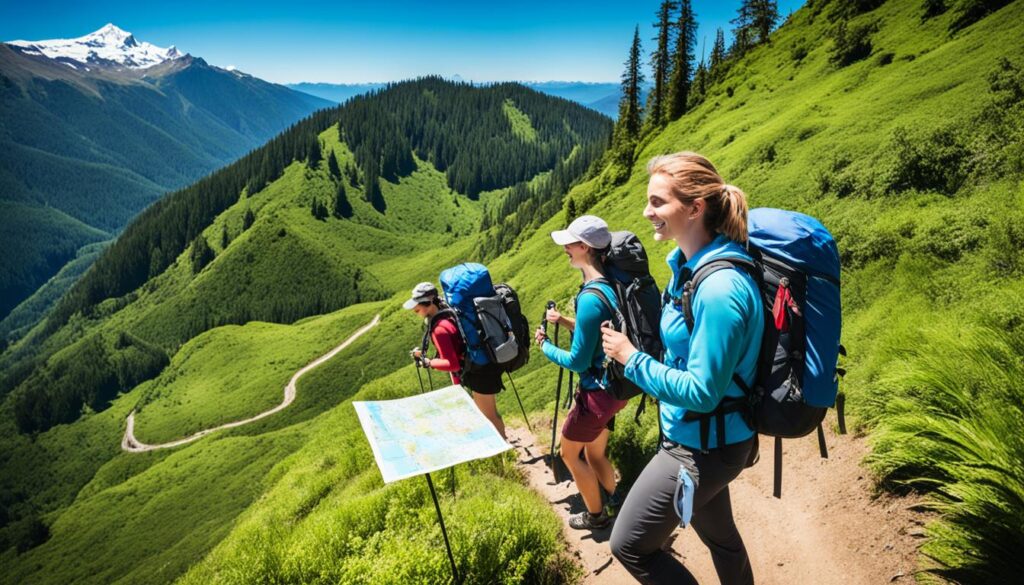Starting your first backpacking trip can be thrilling yet a bit overwhelming. You might wonder, “Where do I begin?” or “What gear do I need?” Finding the right trails for beginners is key. This guide aims to lead you to the best backpacking routes for beginners in the United States. It’s packed with tips, gear advice, and top trails to kickstart your journey.
Table of Contents
ToggleKey Takeaways
- Discover the best beginner-friendly backpacking destinations in the United States
- Learn about the essentials of backpacking 101 and the benefits for new outdoor enthusiasts
- Explore easy hiking trails and overnight backpacking adventures for first-time backpackers
- Get equipped with the necessary gear and equipment for a successful backpacking trip
- Prepare for your first backpacking experience with tips on planning, training, and safety
What is Backpacking?
Backpacking is a thrilling outdoor adventure that lets you connect deeply with nature. You carry all you need, like food and water, on your back. This way, you explore remote trails and scenic spots, making unforgettable memories.
Understanding the Essence of Backpacking
Backpacking is all about being self-sufficient and solving problems on your own. As a beginner, you’ll learn to navigate new places, set up camp, and manage your gear. This experience teaches you to appreciate nature and enjoy the simple things in life.
Benefits of Backpacking for Beginners
Starting with backpacking brings many rewards for newbies. It boosts your fitness, mental health, and sense of adventure. By exploring nature, you gain valuable skills, confidence, and memories that last a lifetime.
“Backpacking is not just a hobby; it’s a way of life that connects you to the world in a profound and meaningful way.” – Jane Doe, avid backpacker
Backpacking lets you experience nature in a unique way, whether it’s a tough overnight trip or a scenic day hike. It opens up a world of freedom, self-reliance, and appreciation for the outdoors.
Choosing the Right Backpacking Routes for Beginners
Starting your first backpacking trip? Picking the right trail is key to a great experience. Look for easy hiking trails, beginner-friendly backpacking destinations, and starter backpacking routes. These will help you succeed and gain confidence on the trail.
When picking a route, think about how hard it is. Choose trails that are easy to follow, have gentle slopes, and aren’t too long. This way, you can enjoy the beautiful views without getting too tired.
Also, consider the trail’s setup. Find routes with nice campsites, easy access to water, and clear signs. This makes your trip more comfortable and lets you enjoy nature without worrying about logistics.
| Beginner-Friendly Backpacking Destinations | Trail Difficulty | Distance |
|---|---|---|
| Appalachian Trail (Georgia) | Easy | 5-10 miles |
| Glacier National Park (Montana) | Moderate | 8-12 miles |
| Great Smoky Mountains (Tennessee) | Easy to Moderate | 6-15 miles |
Think about the difficulty, distance, and setup of trails to pick a great starter backpacking route. With the right easy hiking trails and beginner-friendly backpacking destinations, your first backpacking trip will be exciting and memorable.
Essential Gear for Beginner Backpackers
Getting ready for a backpacking trip means picking the right backpacking gear. As a beginner, you need the right gear for a safe and comfy trip. Let’s look at the main items you should pack.
Backpack Selection Guide
Your backpack is the core of your gear. When picking one, think about its size, how it fits, and its weight. A backpack that fits well and is comfy can greatly improve your hike.
Other Must-Have Backpacking Gear
There are key items you should add to your gear list. These include a strong tent, a warm sleeping bag, a comfy sleeping pad, a headlamp for night, a first-aid kit, and trekking poles for stability.
| Backpacking Gear | Description | Importance |
|---|---|---|
| Backpack | A well-fitting, comfortable backpack with adequate capacity to carry all your essential items. | Distributes the weight evenly and ensures a comfortable hiking experience. |
| Tent | A durable, lightweight, and weatherproof tent to provide shelter during your backpacking trip. | Protects you from the elements and ensures a comfortable sleeping environment. |
| Sleeping Bag | A warm and insulating sleeping bag to keep you cozy and protected during the night. | Helps maintain body temperature and ensures a good night’s sleep. |
| Sleeping Pad | A comfortable and durable sleeping pad to provide cushioning and insulation from the ground. | Enhances sleep quality and prevents heat loss to the ground. |
| Headlamp | A reliable and hands-free headlamp for illumination during nighttime activities. | Provides essential lighting for setting up camp, navigating trails, and performing tasks in the dark. |
| First-Aid Kit | A comprehensive first-aid kit to address any minor injuries or medical emergencies during your trip. | Ensures you can provide immediate care and attention to any health issues that may arise. |
| Trekking Poles | Adjustable trekking poles to provide stability, support, and shock absorption on the trail. | Reduces stress on joints, improves balance, and aids in navigating uneven terrain. |
Being well-prepared with the right gear is key to a great backpacking trip. Take time to research and buy quality gear that will help you on the trail.
Backpacking Routes for Beginners
Starting your first backpacking trip can feel exciting and a bit scary. Luckily, there are many easy trails and beginner-friendly trips waiting for you. The United States has beautiful places perfect for those new to backpacking.
Easy and Scenic Day Hikes
Begin with day hikes to get used to the outdoors. Try the Acadia National Park Loop Trail in Maine, the Emerald Lake State Park Trail in Colorado, or the Kalalau Trail in Hawaii. These trails are easy, beautiful, and have good paths and campsites.
Overnight Backpacking Adventures
After getting some day hiking experience, try an overnight trip. These trips let you really connect with nature. Look into the Appalachian Trail, John Muir Trail, or the Boundary Waters Canoe Area Wilderness. They offer amazing views, nice campsites, and a big adventure.
| Backpacking Route | Location | Difficulty Level | Duration |
|---|---|---|---|
| Acadia National Park Loop Trail | Maine | Easy | Day Hike |
| Emerald Lake State Park Trail | Colorado | Easy | Day Hike |
| Kalalau Trail | Hawaii | Moderate | Day Hike |
| Appalachian Trail | Eastern United States | Moderate to Challenging | Overnight Backpacking |
| John Muir Trail | California | Moderate to Challenging | Overnight Backpacking |
| Boundary Waters Canoe Area Wilderness | Minnesota | Moderate | Overnight Backpacking |

“The journey of a thousand miles begins with a single step. Start your backpacking adventure today!”
Preparing for Your First Backpacking Trip
Starting your first backpacking trip is thrilling yet a bit scary. Getting ready properly is key for a great adventure. Here are the main steps to prepare for your first time in the backcountry.
Training and Conditioning
It’s important to get your body ready for backpacking. Start a training plan to build endurance, strength, and flexibility. You can do this with:
- Cardio exercises like hiking, running, or cycling
- Strength training to carry your gear better
- Yoga or stretching to improve flexibility and balance
Slowly increase your workout time and effort to get your body ready for backpacking.
Planning and Logistics
Good backpacking planning is crucial for a smooth trip. Start by looking into the places you want to go backpacking. Think about the difficulty, terrain, and how far it is. Make a detailed plan with:
- Arrival and departure dates
- Where you’ll stay overnight
- What backpacking gear and supplies you need
- How to contact people and a plan for emergencies
Planning and preparing well will help you have a memorable and safe backpacking trip.
“The journey of a thousand miles begins with a single step.” – Lao Tzu
With good backpacking training and backpacking logistics, you’ll feel ready and excited for your first trip.
Leave No Trace Principles
As responsible backpackers, following the Leave No Trace principles is key. These guidelines help us reduce our impact on nature. They make sure our outdoor adventures are sustainable and leave little trace. By following these principles, we become more eco-friendly and thoughtful outdoor lovers.
The seven core Leave No Trace principles are:
- Plan Ahead and Prepare – Research your destination, pack the right gear, and plan your trip to minimize your impact.
- Travel and Camp on Durable Surfaces – Stick to designated trails and campsites to avoid damaging fragile ecosystems.
- Dispose of Waste Properly – Pack out all your trash, and properly dispose of human waste and gray water.
- Leave What You Find – Resist the temptation to collect natural souvenirs, and leave the area as you found it.
- Minimize Campfire Impacts – Use established fire rings, keep fires small, and fully extinguish them before leaving.
- Respect Wildlife – Observe wildlife from a distance, and store food properly to avoid attracting animals.
- Be Considerate of Other Visitors – Keep your noise and presence mindful of others, and yield to other hikers on the trail.
By adopting these leave no trace principles, you can lessen your impact on nature. This ensures that our natural spaces stay beautiful for future generations. Practicing backpacking ethics and outdoor sustainability is good for the planet and makes backpacking better for you.
Safety Tips for Beginner Backpackers
As a beginner backpacker, your safety is the most important thing. You need to know how to handle wildlife and be ready for emergencies. These steps will help you have a safe and fun outdoor trip.
Dealing with Wildlife Encounters
When you’re in the wild, knowing about the local animals and how to react is key. Here are some tips to keep you safe:
- Learn about the animals you might see and what they usually do.
- Keep your food away from bears and other animals by storing it right.
- Make noise while you hike to warn animals you’re coming and not surprise them.
- Keep a safe distance from any wild animals and don’t go near them.
First Aid and Emergency Preparedness
Even the best-planned trips can have accidents. Being ready with first aid skills and supplies is crucial. Here are some important steps:
- Have a full first aid kit with bandages, antiseptic, painkillers, and any needed medicines.
- Learn basic first aid like treating blisters, sprains, and small cuts.
- Know how to call for help and have a plan for emergencies.
- Understand the area you’re hiking in and the dangers it might have, and plan your path carefully.
By focusing on backpacking safety, being aware of backpacking wildlife, and being ready for backpacking first aid, you can start your backpacking trips feeling confident. Being ahead of backpacking emergencies is what makes for a safe and great outdoor trip.
Backpacking Routes for Beginners
Starting your first backpacking trip can be thrilling and a bit scary. Luckily, there are many easy hiking trails, beginner-friendly backpacking destinations, and starter backpacking routes for newbies. These paths offer beautiful views, easy distances, and well-kept campsites for a great first-time backpacking experience.
The Appalachian Trail is a top pick for beginner backpacking trips. It runs from Georgia to Maine and has clear paths, easy campsites, and amazing views. Another great spot is the Superior Hiking Trail in Minnesota. It has beautiful North Woods views and easy terrain.
For a coastal adventure, try the Lost Coast Trail in California or the Ozark Highland Trail in Arkansas. These trails show off different landscapes, from steep cliffs to quiet forests. They let you enjoy nature without the hard parts of tougher trails.
Choosing easy hiking trails or beginner-friendly backpacking destinations is key. Start with starter backpacking routes to gain confidence and skills. With the right prep and attitude, your first trip will be unforgettable and fulfilling.
| Beginner Backpacking Destination | Highlights | Distance |
|---|---|---|
| Appalachian Trail | Well-marked paths, accessible campsites, stunning vistas | Varies (2,194 miles total) |
| Superior Hiking Trail | Picturesque North Woods scenery, relatively gentle terrain | Approximately 310 miles |
| Lost Coast Trail | Rugged coastal cliffs, diverse natural landscapes | Approximately 24 miles |
| Ozark Highland Trail | Serene forests, accessible trail system | Approximately 165 miles |

“The real voyage of discovery consists not in seeking new landscapes, but in having new eyes.”
– Marcel Proust
Choosing the right beginner-friendly backpacking destination is crucial. Start with easy hiking trails and starter backpacking routes to gain confidence. This will help you move on to harder adventures later.
Navigating the Trail
Learning how to navigate the trail is key for beginners in backpacking. It’s important whether you’re going for a day hike or a long trip. Knowing how to read maps and use a compass can help you get to your destination safely and with confidence.
Reading Maps and Using a Compass
Understanding map reading and compass skills is vital for outdoor adventures. Backpacking maps show you the terrain, trails, and landmarks you’ll see. Learning about these maps helps you plan your path, spot challenges, and stay on course.
A backpacking compass is also crucial for backpacking navigation. It lets you align with the map and track your direction. This way, you can make smart choices about where to go, even in new places.
Here are some tips to boost your confidence in navigating the trail:
- Study your map well before you go, looking at landmarks, trail signs, and dangers.
- Get to know your compass and practice using it to find your direction and location.
- Check where you are often and change your path if needed to stay on course.
- Pay attention to your surroundings and look for natural signs to help you get your bearings.
Mastering map reading and compass skills makes you a confident backpacker. You’ll be able to navigate trails easily and enjoy the outdoors with adventure and safety.
Camping and Cooking on the Trail
Backpacking takes you into the great outdoors, where you set up camp and cook meals on the trail. It’s for both seasoned backpackers and beginners looking to improve their outdoor skills. Learning about backpacking camping and cooking can make your trip better.
Choosing the right gear is key to a good camping experience. You need a strong, light tent and a reliable camp stove. Each piece of gear is important for a comfy and fun backcountry stay.
Mastering the Art of Backpacking Meals
Preparing tasty and healthy meals on the trail is a fun challenge. You must plan your meals well. Think about how much calories you need, how easy it is to make, and how much it weighs. Dehydrated and freeze-dried foods are great because they’re light and last a long time. Adding fresh ingredients can make your meals more exciting.
- Try quick and easy recipes that work well with your camp stove and little gear.
- Choose ingredients that can be used in many dishes to increase your meal choices.
- Get a good insulated food container to keep your food fresh and at the right temperature.
| Backpacking Meal Type | Recommended Dishes | Cooking Time |
|---|---|---|
| Breakfast | Oatmeal, granola, dehydrated eggs | 5-10 minutes |
| Lunch | Wraps, trail mix, dried fruit | No cooking required |
| Dinner | Pasta, rice dishes, dehydrated stews | 10-20 minutes |
Getting good at backpacking cooking helps you stay healthy and makes your trip better. It creates memories that will stay with you long after you’re back home.
“The true essence of backpacking lies in the simple pleasures of preparing a warm meal and sharing it with your companions under the stars.”
Embracing the Backpacking Lifestyle
Backpacking is more than just a way to stay active. It changes your mind and heart. When you start backpacking, you’ll see how being in nature helps you feel better.
Connecting with Nature
The backpacking lifestyle lets you connect deeply with nature. It’s a chance to slow down and see the beauty around you. Nature’s sights, sounds, and smells can make you feel calm and reduce stress.
Building Confidence and Self-Reliance
Backpacking pushes you out of your comfort zone. It helps you become more confident and self-reliant. You’ll learn to trust yourself and solve problems on your own. This confidence can help you in other parts of life too.
The backpacking lifestyle is a chance to grow and connect with nature. It’s a journey that can make your life richer in many ways.
Resources for Beginner Backpackers
Starting your backpacking journey means you need lots of information and support. You can find this in websites, books, and online communities. These resources will help guide you through the world of backpacking.
Backpacking Websites and Blogs
Check out these great websites to stay up-to-date and inspired:
- REI Expert Advice – Get guides on backpacking basics, planning, and skills.
- Outside Magazine – A trusted source for backpacking news, gear reviews, and trip ideas.
- The Outbound Collective – Find inspiring stories, route tips, and community content.
Backpacking Books and Guides
Learn more with these key backpacking books:
- The Complete Guide to Backpacking by Tristan Gooley
- Backpacking 101 by Heather Balogh Rochfort
- Backpacker Magazine’s Complete Guide to Outdoor Gear Maintenance and Repair by Kristin Hostetter
Backpacking Communities
Meet other backpackers and learn from their stories:
- Backpackers Connected – A Facebook group for sharing tips, trip reports, and gear advice.
- r/Ultralight on Reddit – Focuses on minimalist and lightweight backpacking gear and methods.
- Backpacking Meetup Groups – Local groups for organizing hikes, camping trips, and social events.
With these amazing backpacking resources, backpacking tips, backpacking guides, and active backpacking communities, you’re set for your next outdoor adventure.
Conclusion
As we finish this guide on backpacking routes for beginners, we hope you’re ready to start your first backpacking adventure. You can pick an easy hiking trail or go for an overnight backpacking trip. The joy of exploring nature with just the basics is unforgettable.
This guide has given you the key tools and info to begin your backpacking journey. It’s not just about getting to the end. It’s about connecting with nature, learning to rely on yourself, and making memories that last.
So, what are you waiting for? Pick up your backpack, put on your boots, and get set to explore the outdoors as a first-time backpacker. You can choose a beginner-friendly backpacking destination or a starter backpacking route. The adventure is waiting. Happy trails!
FAQ
What is the difference between backpacking and regular hiking?
Backpacking means carrying all your gear, like a tent and sleeping bag, on your back. Hiking is usually a day trip with just a small pack. Backpacking lets you stay outdoors for days, while hiking is for a day.
What are the benefits of backpacking for beginners?
Backpacking is great for beginners. It helps you disconnect, challenge yourself, and enjoy nature more. You’ll also learn to solve problems and feel more adventurous.
How do I choose the right backpacking route for my skill level?
Pick trails that are easy to follow and not too long for beginners. Look for trails with campsites and water nearby. Ask local outfitters or land agencies for trails that are good for beginners.
What essential gear do I need for my first backpacking trip?
You’ll need a good backpack, hiking boots, a tent, sleeping gear, and a portable stove. Don’t forget food, water, first aid, and a map.
How do I prepare for my first backpacking trip?
Get ready by hiking and exercising to build up your strength. Research your trail, plan meals, and pack all your gear.
What are the Leave No Trace principles, and why are they important for backpackers?
Leave No Trace means taking care of nature by disposing of waste properly and respecting wildlife. It helps keep the outdoors beautiful for everyone.
How can I stay safe on the trail as a beginner backpacker?
Stay safe by being ready for wildlife, carrying first aid, and knowing how to navigate. Always check the weather and tell someone your plans.
What are some beginner-friendly backpacking routes to consider?
Great trails for beginners include the Appalachian Trail, John Muir Trail, and Superior Hiking Trail. They’re scenic, easy to follow, and perfect for first-timers.
How do I navigate the trail and avoid getting lost?
Learn to read maps and use a compass. Know the trail and its signs before you go. Use a GPS or app, but always have a map and compass too.
What are some tips for camping and cooking on the trail?
When camping, follow Leave No Trace by choosing a good spot and storing food right. For cooking, pick easy meals and bring all your gear.









